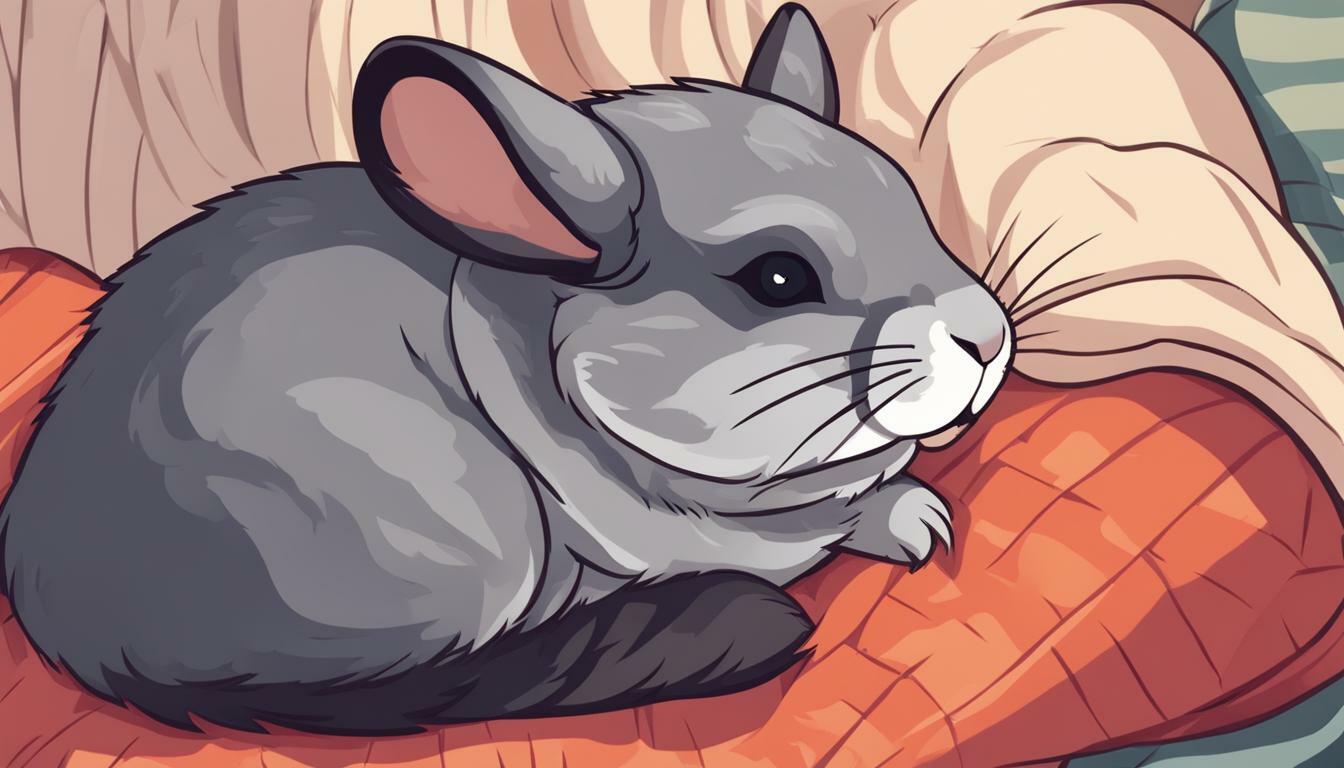Curious if chinchillas like to cuddle? In this comprehensive guide, we will delve into their cuddling habits and explore their bonding behavior.
Key Takeaways:
- Chinchillas have varying preferences when it comes to cuddling.
- It depends on their socialization and individual personality.
- Forced cuddling should be avoided. Start with small interactions and respect their space.
- Chinchillas become more comfortable with cuddling over time through patience, bonding, and proper conditioning.
- Reading chinchilla body language is crucial for understanding their comfort level with cuddling.
Understanding Chinchilla Behavior
Before diving into their cuddling preferences, it’s essential to understand chinchilla behavior and how it influences their affectionate nature. Chinchillas are naturally curious and cautious creatures, known for their ability to jump high and escape perceived threats. They have a strong prey instinct and may be initially wary of human interaction.
Building trust is key to developing a bond with your chinchilla. Start by creating a calm and secure environment for them, with plenty of hiding spots and things to chew on. Avoid sudden movements or loud noises that can startle them. Gradually introduce yourself to your chinchilla by offering treats or allowing them to sniff your hand. It’s important to let them approach you at their own pace.
Once your chinchilla begins to feel comfortable in their surroundings, you can start to establish a routine of regular interactions. This can include gentle petting, offering treats from your hand, or simply sitting near their cage and talking to them softly. Remember to always respect your chinchilla’s boundaries and avoid forcing physical contact.
Chinchillas have individual personalities, and some may never develop a strong affinity for cuddling. However, with patience and proper conditioning, you may find that your chinchilla becomes more receptive to affection over time. Pay attention to their body language, as it can provide valuable insights into their comfort level. If your chinchilla shows signs of stress or discomfort, it’s important to back off and reassess your approach.
| Key Points: |
|---|
| Chinchillas are naturally cautious and may be skeptical of human interaction. |
| Building trust is crucial to developing a bond with your chinchilla. |
| Respect your chinchilla’s boundaries and avoid forcing physical contact. |
| Pay attention to their body language and adjust your approach accordingly. |
Building Trust and Bonding
Building a strong bond with your chinchilla is crucial if you want to create a cuddly and affectionate relationship. Chinchillas have varying preferences when it comes to cuddling, and it depends on their socialization and individual personality. While some chinchillas may enjoy cuddling, others may never warm up to it. It is important to give chinchillas time to adjust to their new environment and build trust before attempting to cuddle them.
Forced cuddling should be avoided, as it can cause distress and damage the trust you’ve built. Instead, start with small interactions and respect their space. Offer treats and speak to your chinchilla in a soothing voice, allowing them to gradually become accustomed to your presence. Patience is key in building a strong bond with your chinchilla.
Chinchillas become more comfortable and may show more affection over time with patience, bonding, and proper conditioning. Spend time with your chinchilla by sitting near their cage or enclosure, talking to them gently, and offering treats. This will help them associate your presence with positive experiences, leading to increased trust and potential cuddling opportunities.
It’s important to note that some chinchillas may never enjoy cuddling, no matter how much trust and bonding you establish. It’s crucial to read their body language and respect their boundaries. A chinchilla’s comfort level can be determined by the position of their ears, body posture, and vocalizations. If they exhibit signs of stress or discomfort, it’s best to give them space and explore other ways to bond and show affection, such as interactive playtime or gentle grooming sessions.
| Key Points: |
|---|
| – Building trust is essential for a cuddly relationship with your chinchilla |
| – Give your chinchilla time to adjust and build trust before attempting cuddling |
| – Avoid forced cuddling and respect your chinchilla’s boundaries |
| – Some chinchillas may never enjoy cuddling, so it’s important to read their body language and find alternative bonding activities |
| – Spend time with your chinchilla, offering treats and speaking in a soothing voice to build trust |
Cuddling vs. Forced Cuddling
Cuddling with your chinchilla should always be a voluntary and enjoyable experience for both of you. Chinchillas have their own unique personalities and comfort levels when it comes to physical contact, so it’s important to respect their boundaries and avoid forcing them into cuddling.
When attempting to cuddle with your chinchilla, start with small interactions and give them space to adjust. Forced cuddling can lead to stress and anxiety for your furry friend, and it may negatively impact your bond. Instead, focus on creating a positive and comfortable environment that encourages your chinchilla to approach you willingly.
One way to build trust and improve your chinchilla’s willingness to cuddle is through gradual conditioning. Start by offering treats or gentle strokes while your chinchilla is in their cage. Over time, they will begin associating your touch with positive experiences. Patience is key here, as it may take some chinchillas longer than others to feel comfortable with physical contact.
| Key Points: |
|---|
| Respect your chinchilla’s boundaries and avoid forced cuddling |
| Create a comfortable environment to encourage voluntary cuddling |
| Gradually condition your chinchilla to associate physical contact with positive experiences |
It’s important to read your chinchilla’s body language to ensure they are receptive to cuddling. Signs of discomfort or stress include flattened ears, tucking their tail, and attempting to escape your grasp. If you notice these signals, it’s best to give your chinchilla some space and try again later.
Remember that not all chinchillas enjoy cuddling, and that’s perfectly okay. They may have other ways of showing affection, such as grooming you or simply being in your presence. The most important thing is to build a strong bond with your chinchilla through trust, patience, and regular interaction.
Reading Chinchilla Body Language
Chinchillas communicate through body language, and understanding their signals can help you gauge their interest in cuddling. By carefully observing their behavior, you can determine if they are receptive to physical contact or if they prefer to maintain their space. Here are some key body language cues to look out for:
- Ears: When a chinchilla’s ears are perked up and facing forward, it indicates their curiosity and engagement. However, if their ears are flattened against their head, it may be a sign that they are feeling anxious or uncomfortable. Take this as a cue to give them some space and reassess your approach.
- Posture: A relaxed chinchilla will have a slightly arched back, while a tense or hunched posture may suggest uneasiness. Be mindful of their body language and adjust your interactions accordingly.
- Tail: A chinchilla’s tail can provide valuable insights into their mood. A calm and relaxed chinchilla will keep their tail in a neutral position, while a twitching or rapidly wagging tail might indicate agitation or anxiety. Take note of their tail movements to gauge their comfort level.
- Approach: Chinchillas that show curiosity and approach you willingly are more likely to be receptive to cuddling. If they willingly come closer and show interest in interacting with you, it may be a good time to attempt gentle physical contact.
Remember, every chinchilla is unique, and their body language could vary slightly. It is crucial to spend time observing and understanding your chinchilla’s individual cues to ensure a positive and comfortable cuddling experience.
Table 1: Chinchilla Body Language Cues
| Cue | Meaning |
|---|---|
| Ears perked up and facing forward | Curiosity and engagement |
| Ears flattened against head | Anxiety or discomfort |
| Relaxed, slightly arched back | Calming and comfortable |
| Twitching or rapidly wagging tail | Agitation or anxiety |
| Approaching willingly | Receptiveness to interaction |
By being attentive to these body language cues, you can determine if your chinchilla is open to cuddling or if they need more time and space to feel comfortable. Remember to always approach your chinchilla gently and provide positive reinforcement to build trust. With patience, bonding, and understanding their unique preferences, you can create a stronger bond and potentially enjoy cuddling with your chinchilla.
Socialization and Cuddling
Chinchillas that have been socialized from a young age are more likely to enjoy cuddling and human interaction. Proper socialization plays a crucial role in their ability to bond with humans and feel comfortable in their presence. When chinchillas are exposed to positive experiences with humans early on, they are more likely to develop trust and show affection through cuddling.
Creating a warm and inviting environment is key to fostering a strong bond with your chinchilla. Providing a spacious cage with plenty of hiding spots, toys, and enrichment activities can help them feel secure and stimulated. Chinchillas thrive in a routine, so it’s important to establish a consistent schedule for feeding, playtime, and cuddling sessions.
When attempting to cuddle with your chinchilla, it’s essential to start with small interactions and respect their personal space. Begin by offering treats or gentle strokes to build trust and gradually increase physical contact. Pay close attention to their body language, as it can indicate whether they are comfortable or stressed. If your chinchilla shows signs of distress, such as hiding, vocalizing, or attempting to escape, it’s crucial to back off and give them space.
| Signs of a comfortable chinchilla | Signs of a stressed chinchilla |
|---|---|
|
|
Remember, chinchillas are independent creatures with unique personalities. While some chinchillas may enjoy cuddling, others may never warm up to it. It’s important to respect their individual preferences and not force them into unwanted physical contact.
Regular attention and playtime are crucial for chinchillas’ overall well-being and can enhance the bond between you and your furry friend. Engage in interactive activities, such as supervised exploration outside the cage or offering them safe toys to play with. These interactions can strengthen the trust and connection between you and your chinchilla, making them more open to cuddling.
With patience, bonding, and proper conditioning, your chinchilla may become more comfortable with cuddling over time. However, it’s important to remember that some chinchillas may never fully enjoy cuddling, and that’s okay. It’s essential to appreciate and respect their unique personalities and find alternative ways to show them affection and bond with them.
Patience and Conditioning
Patience and proper conditioning are key when trying to cultivate a cuddly relationship with your chinchilla. These small, delicate creatures are naturally cautious and may take some time to warm up to human interaction. It is important to establish trust before attempting to cuddle or handle them extensively.
Start by creating a calm and comfortable environment for your chinchilla. Provide a spacious cage with plenty of hiding spots and toys to keep them stimulated. Spend time near the cage, talking softly and offering treats to help them associate your presence with positive experiences.
When your chinchilla begins to show curiosity and an interest in interacting with you, start with small interactions. Place your hand flat in the cage and allow them to approach and sniff it at their own pace. Avoid sudden movements or attempts to grab them, as this may startle or frighten them.
| Cuddle Tips | Do’s | Don’ts |
|---|---|---|
| Start with short sessions | Show gentle and slow movements | Force cuddling |
| Use soft, calm voice | Provide treats or favorite foods | Surprise or startle your chinchilla |
| Respect their boundaries | Offer a safe and comfortable space for cuddling | Overwhelm or crowd your chinchilla |
It’s important to respect your chinchilla’s boundaries. If they show signs of discomfort or begin to retreat, give them space and try again later. Regular, positive interactions will help build trust and increase their comfort level with cuddling over time.
Building Trust with Your Chinchilla
In order to build a strong bond with your chinchilla, it’s crucial to establish trust. Spend quality time together, providing gentle and patient care. Offer treats and rewards as a way to reinforce positive behavior. Gradually increase the duration of your cuddle sessions as your chinchilla becomes more comfortable.
Remember, not all chinchillas will enjoy cuddling. Respect their individual preferences and find alternative ways to show affection and bond. Some chinchillas may prefer playtime or interactive toys that allow them to engage with you in their own way. Through patience, understanding, and a positive approach, you can nurture a loving relationship with your chinchilla that goes beyond cuddling.
Chinchillas That Don’t Enjoy Cuddling
While some chinchillas are avid cuddlers, others may simply prefer different forms of interaction. Each chinchilla has its own unique personality and preferences, and it’s important to respect their individual boundaries. If your chinchilla doesn’t enjoy cuddling, don’t be disheartened. There are still plenty of ways to bond and show affection to your furry friend.
When interacting with a chinchilla that doesn’t enjoy cuddling, it’s crucial to read their body language and respect their comfort levels. Observe their behavior to determine if they are feeling stressed or anxious. If they show signs of distress, such as trying to escape or vocalizing their discomfort, it’s best to give them space and find alternative ways to interact.
Instead of cuddling, focus on creating a stimulating and enriching environment for your chinchilla. Provide them with plenty of toys, tunnels, and platforms to explore. Engage in interactive play sessions using safe and chinchilla-friendly toys. These activities will not only keep your chinchilla physically active but also mentally stimulated, preventing boredom and potential depression.
| Activities for Chinchilla Playtime: |
|---|
| 1. Provide chew toys made of safe materials like untreated wood or hard plastic. |
| 2. Create an obstacle course using tunnels, ramps, and platforms. |
| 3. Offer a dust bath for your chinchilla to roll and clean themselves. |
| 4. Hide treats or hay around their habitat to encourage foraging behavior. |
| 5. Rotate toys regularly to keep things interesting and prevent boredom. |
Remember, trust and bonding take time with chinchillas that don’t enjoy cuddling. Spend quality time near your chinchilla’s habitat, talking softly and offering treats. Let them come to you on their terms, gradually building trust and establishing a positive association with your presence. With patience and consistency, your chinchilla may become more comfortable over time, and their willingness to interact and show affection may increase.
Attention and Playtime
Regular attention and playtime are essential to ensure your chinchilla stays happy and engaged, which can contribute to a more affectionate relationship. Chinchillas are active and social animals that require mental and physical stimulation to thrive. By providing regular attention and playtime, you can not only prevent boredom and potential depression but also strengthen your bond with your furry friend.
During playtime, create a safe and enriching environment for your chinchilla. You can set up a play area with tunnels, toys, and climbing structures, allowing them to explore, jump, and exercise. Supervise your chinchilla during playtime to ensure their safety and prevent any accidents or chewing on dangerous objects.
Engaging in interactive play with your chinchilla can also help strengthen your bond. Use toys that encourage natural behaviors such as foraging or chewing to keep them mentally stimulated. You can hide treats or pellets in puzzle toys or offer chew toys made of safe materials like apple wood or pumice stone.
| Playtime Tips |
|---|
| 1. Set aside dedicated playtime each day to spend with your chinchilla. |
| 2. Rotate toys and provide new ones to keep them interested and engaged. |
| 3. Supervise your chinchilla closely to ensure their safety during play. |
| 4. Avoid sudden or loud noises that may startle or stress your chinchilla. |
Remember that chinchillas have their own personalities, and some may be more receptive to playtime and attention than others. Respect their boundaries and observe their body language to determine what they enjoy and what makes them uncomfortable. If your chinchilla shows signs of stress or fear, give them space and try again later when they feel more at ease.
Training and Acclimation
Through proper training and acclimation, you can increase your chinchilla’s comfort level with cuddling and strengthen your bond. It is essential to approach this process with patience and respect for your chinchilla’s boundaries. Start by gradually introducing your chinchilla to physical contact, allowing them to approach you on their terms.
One effective method is to offer treats or favorite foods while gently petting your chinchilla. This positive association helps them associate human touch with something pleasant. Take it slow and pay attention to their body language. If they become stressed or anxious, back off and try again later.
Creating a comfortable environment is crucial for successful training and acclimation. Ensure your chinchilla’s cage is equipped with hiding spots and toys to provide a sense of security. Offer a soft blanket or towel during cuddle time to provide a cozy surface and reduce any apprehension they may feel.
Remember, not all chinchillas will enjoy cuddling, no matter how much effort you put into training and acclimation. It is essential to respect their individual preferences and find other ways to bond and show affection. Playtime and interactive toys can be a great alternative, allowing them to engage in activities they enjoy while still strengthening your relationship.
| Training and Acclimation Tips |
|---|
| 1. Start slow: Gradually introduce your chinchilla to physical contact, allowing them to approach you on their terms. |
| 2. Use positive reinforcement: Offer treats or favorite foods while gently petting your chinchilla to create a positive association with human touch. |
| 3. Pay attention to body language: Watch for signs of stress or anxiety, and adjust your approach accordingly. |
| 4. Create a comfortable space: Provide hiding spots, toys, and a soft blanket or towel during cuddle time to make your chinchilla feel safe and secure. |
| 5. Respect their preferences: Not all chinchillas enjoy cuddling, so find other ways to bond and show affection, such as playtime and interactive toys. |
Conclusion
In conclusion, chinchillas may or may not enjoy cuddling, depending on their individual temperament and socialization. While some chinchillas naturally gravitate towards physical affection, others may never warm up to it. It is crucial to understand and respect their boundaries, as forcing cuddling can lead to stress and discomfort.
When introducing your chinchilla to cuddling, it is recommended to start with small interactions and gradually build trust over time. Allow them to become familiar with your scent and presence before attempting any physical contact. This step-by-step approach will help them feel more comfortable and safe in your presence.
Reading your chinchilla’s body language is vital in understanding their comfort level with cuddling. Pay attention to signs of relaxation, such as relaxed body posture, closed eyes, and grooming behaviors. Conversely, if they exhibit signs of stress, such as tense body posture or attempts to escape, it’s essential to give them space and reassess your approach.
Socialization plays a significant role in chinchilla bonding behavior. Chinchillas from reputable breeders who prioritize socialization are more likely to enjoy being held and cuddled. However, even with proper socialization, some chinchillas may never fully warm up to the idea of cuddling. It’s important to respect their individual preferences and find alternative ways to bond and show affection.
Regular attention and playtime are crucial for chinchillas to maintain a healthy and happy lifestyle. Engaging them in stimulating activities and providing opportunities for exercise can help alleviate boredom and potential depression. Training and acclimation can also play a pivotal role in helping chinchillas feel more comfortable with human handling, including cuddling.
Remember, every chinchilla is unique, and building a bond takes time, patience, and proper conditioning. By creating a secure and nurturing environment, respecting their boundaries, and allowing them to dictate the pace of affection, you can cultivate a loving and affectionate relationship with your furry friend. Whether your chinchilla enjoys cuddling or not, the most important aspect is the mutual trust and understanding that develops between the two of you.
FAQ
Do chinchillas enjoy cuddling?
Chinchillas have varying preferences when it comes to cuddling. While some chinchillas may enjoy cuddling, others may never warm up to it. It depends on their socialization and individual personality.
How can I bond with my chinchilla?
It is important to give chinchillas time to adjust to their new environment and build trust before attempting to cuddle them. Start with small interactions and respect their space. Chinchillas become more comfortable over time with patience, bonding, and proper conditioning.
Can I force my chinchilla to cuddle?
Forced cuddling should be avoided. It is recommended to respect your chinchilla’s boundaries and start with small interactions. With time and trust, they may become more comfortable with cuddling.
How can I read my chinchilla’s body language to know if they want to cuddle?
Reading your chinchilla’s body language is important to gauge their comfort level with cuddling. Signs of receptiveness may include relaxed posture, seeking physical contact, and purring. Signs of discomfort may include squealing, biting, or trying to escape.
Are chinchillas more likely to enjoy cuddling if they are socialized?
Socialized chinchillas from reputable breeders are more likely to enjoy being held and cuddled. Proper breeding and upbringing can positively influence their bonding behavior.
How can I make my chinchilla more comfortable with cuddling?
Patience and conditioning are key. Gradually acclimate your chinchilla to cuddling by starting with short sessions and providing positive reinforcement. Create a safe and comfortable environment for cuddle time.
What if my chinchilla doesn’t enjoy cuddling?
Some chinchillas may never enjoy cuddling, and it is important to respect their individual preferences. Find alternative ways to bond and show affection, such as interactive playtime and providing mental stimulation.
How important is regular attention and playtime for bonding with my chinchilla?
Regular attention and playtime are necessary for chinchillas to avoid boredom and potential depression. Engage in interactive activities that promote bonding and strengthen your relationship.
Can I train my chinchilla to be more comfortable with cuddling?
Training and acclimation can help chinchillas feel more comfortable with human handling. Gradually introduce physical contact and create positive associations with cuddle time through rewards and gentle handling.
In summary, do chinchillas enjoy cuddling?
While some chinchillas may enjoy cuddling, others may prefer alternative forms of bonding. It is important to respect their individual preferences and build trust through patience and proper socialization.




